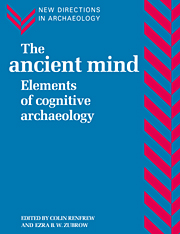Book contents
- Frontmatter
- Contents
- List of figures
- List of tables
- List of contributors
- Preface
- PART I INTRODUCTION
- PART II THE INTERDISCIPLINARY UNDERPINNING
- PART III APPROACHES TO CULT PRACTICE AND TRANSCENDENTAL BELIEF SYSTEMS
- 6 The archaeology of religion
- 7 Ancient Zapotec ritual and religion: an application of the direct historical approach
- 8 The meaning of death: funerary beliefs and the prehistorian
- 9 Prehistoric cognition and the science of archaeology
- PART IV PREHISTORIC CONCEPTIONS OF SPACE AND TIME
- PART V THE MATERIAL BASIS OF COGNITIVE INFERENCE: TECHNOLOGY
- PART VI THE MATERIAL BASIS OF COGNITIVE INFERENCE: WRITING SYSTEMS
- PART VII CONCLUSION
- Index
9 - Prehistoric cognition and the science of archaeology
Published online by Cambridge University Press: 03 December 2009
- Frontmatter
- Contents
- List of figures
- List of tables
- List of contributors
- Preface
- PART I INTRODUCTION
- PART II THE INTERDISCIPLINARY UNDERPINNING
- PART III APPROACHES TO CULT PRACTICE AND TRANSCENDENTAL BELIEF SYSTEMS
- 6 The archaeology of religion
- 7 Ancient Zapotec ritual and religion: an application of the direct historical approach
- 8 The meaning of death: funerary beliefs and the prehistorian
- 9 Prehistoric cognition and the science of archaeology
- PART IV PREHISTORIC CONCEPTIONS OF SPACE AND TIME
- PART V THE MATERIAL BASIS OF COGNITIVE INFERENCE: TECHNOLOGY
- PART VI THE MATERIAL BASIS OF COGNITIVE INFERENCE: WRITING SYSTEMS
- PART VII CONCLUSION
- Index
Summary
… different kinds of phenomena are never remote; they are either accessible or they are not. ‘Nonmaterial’ aspects of culture are accessible in direct measure with the testability of propositions being advanced about them.
(Binford 1968: 22)Introduction
Given that there has been increasing interest among archaeologists in reconstructing what might be called prehistoric ‘mental things’ (e.g. cognition, perception, ideology, symbolism, values, beliefs etc.), and given that it would be interesting to do so, it behoves us, as scientists, to explore whether, or to what degree, it can be done within the framework of the general method of science. Thus, the question I am asking in this chapter is: ‘To what degree are prehistoric thoughts knowable within the context of hypothesis testing?’ Can we actually test ideas which we may have about such things?
I have long maintained that it is not possible to learn about what was in the minds of prehistoric people - these minds are gone, and their mental contents are not recoverable. While we can examine many aspects of what they did, we can understand nothing about what they thought about what they did. But is this really true?
Although I continue to maintain that we cannot actually know what prehistoric people thought, I now think that it is sometimes possible to make plausible inferences about what they must almost certainly have thought, given very strong circumstantial and analogical evidence.
- Type
- Chapter
- Information
- The Ancient MindElements of Cognitive Archaeology, pp. 83 - 92Publisher: Cambridge University PressPrint publication year: 1994
- 10
- Cited by

